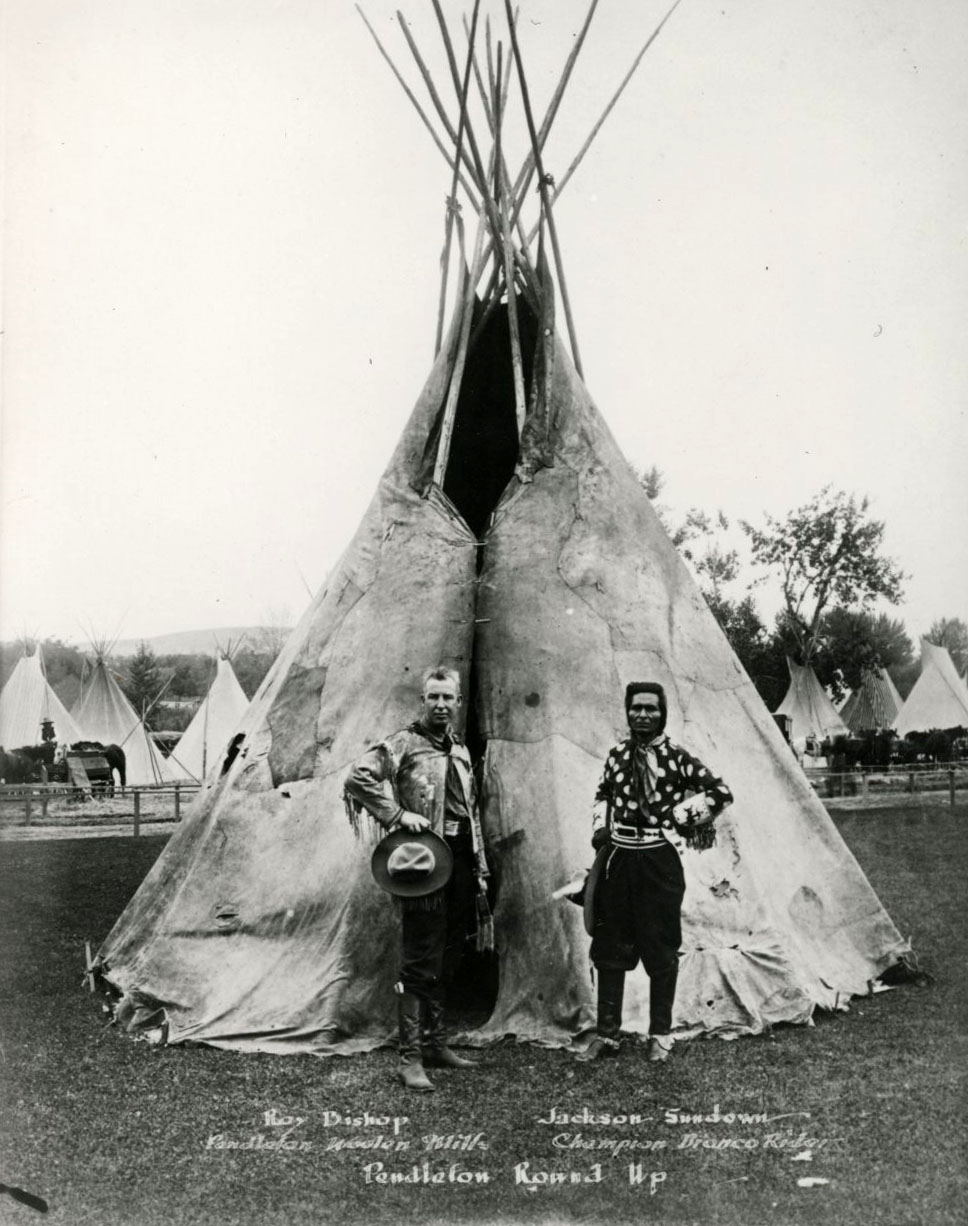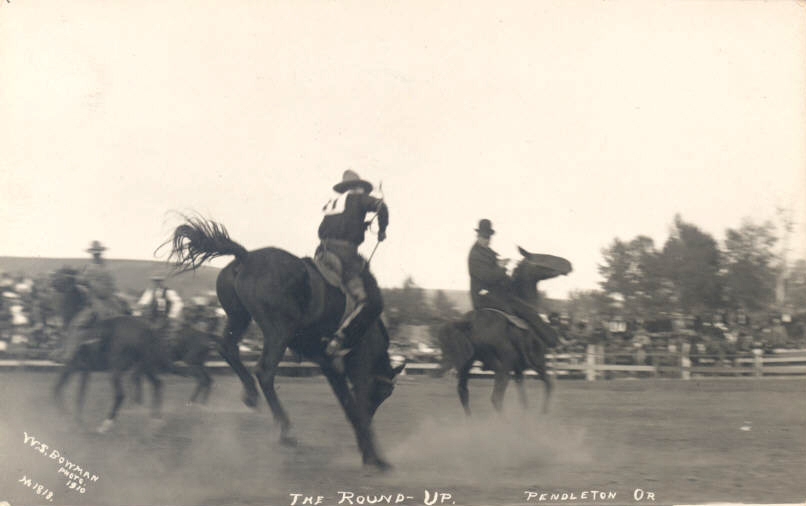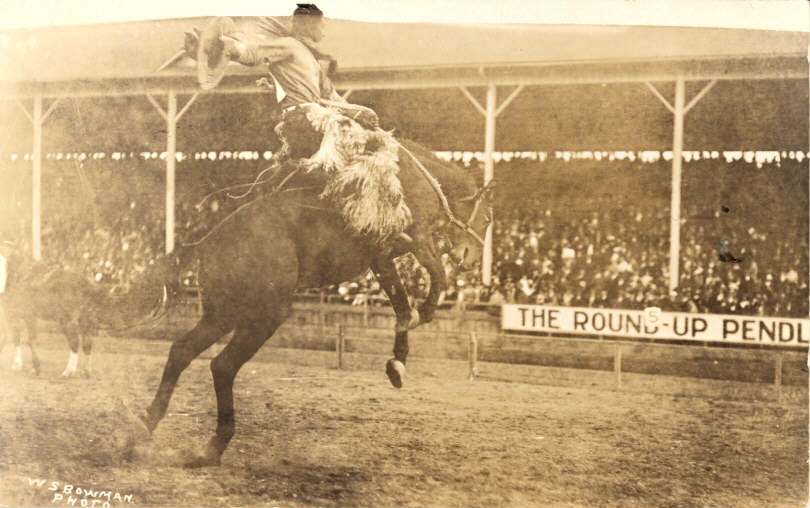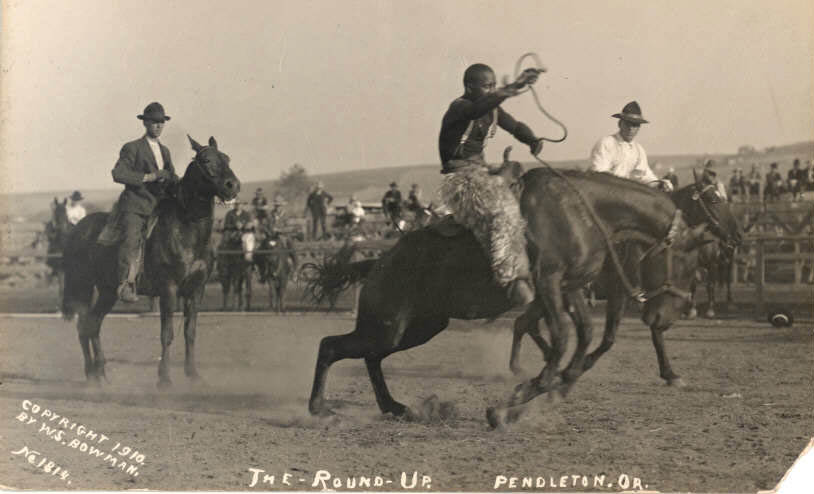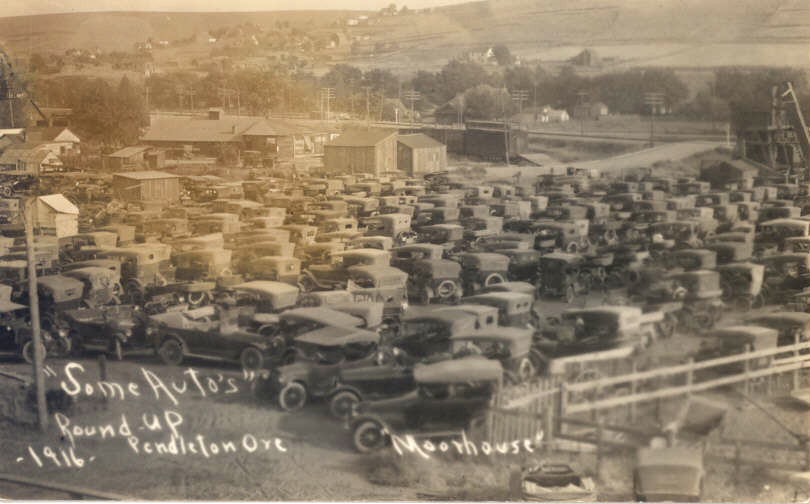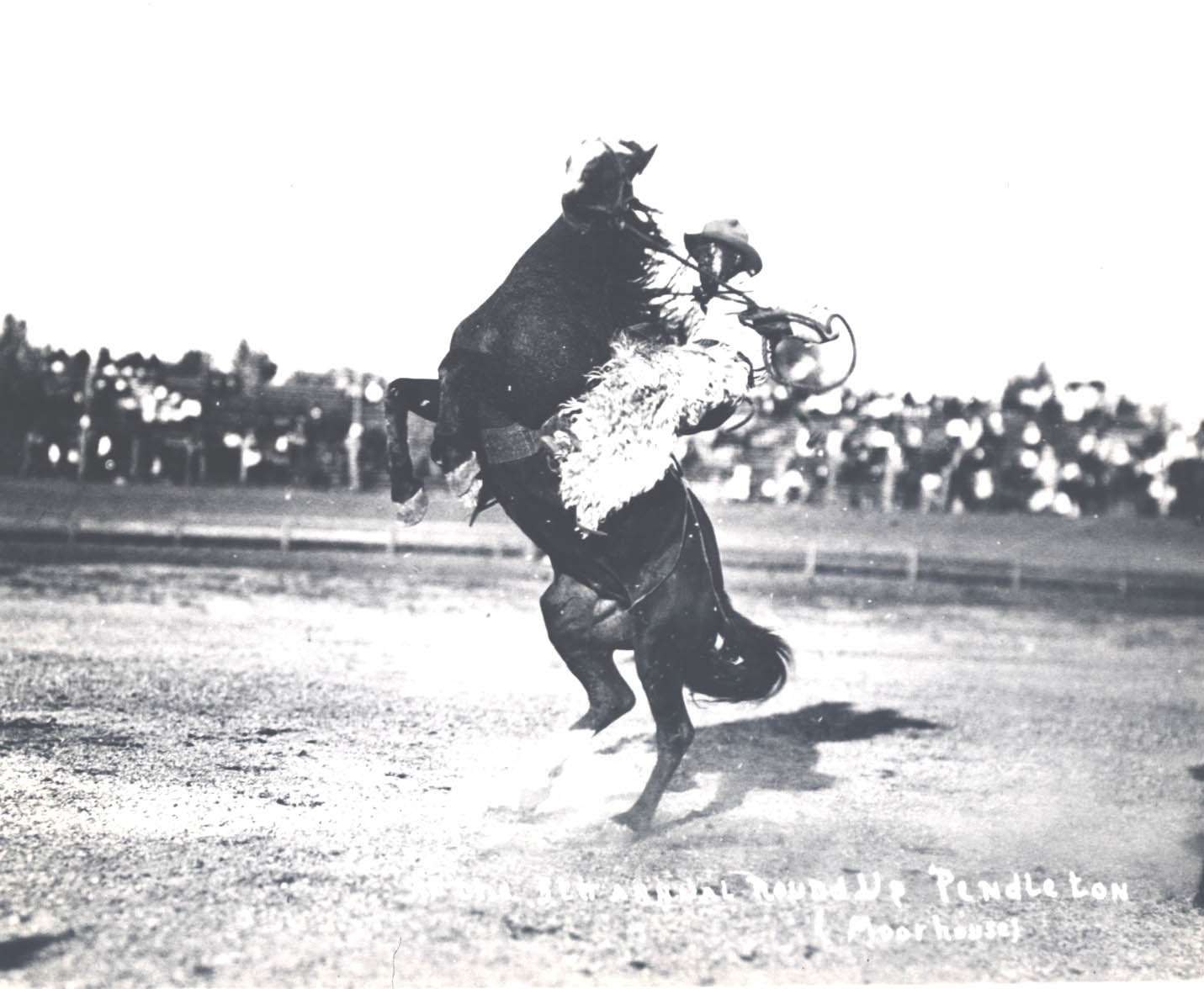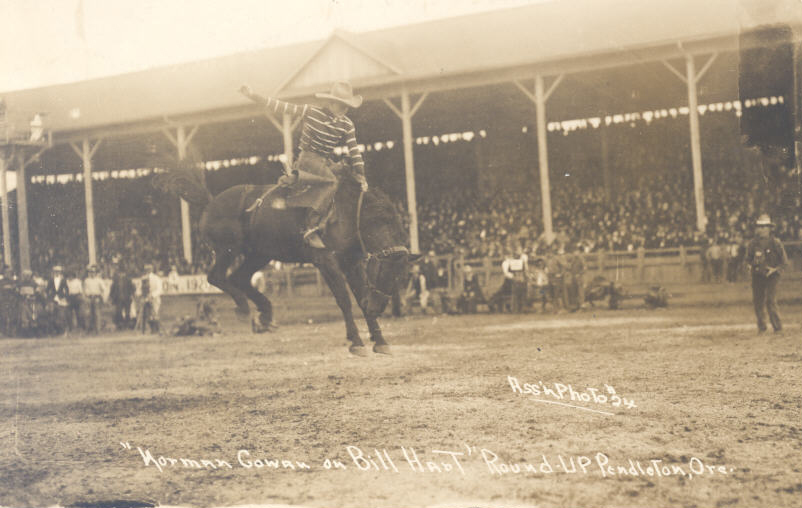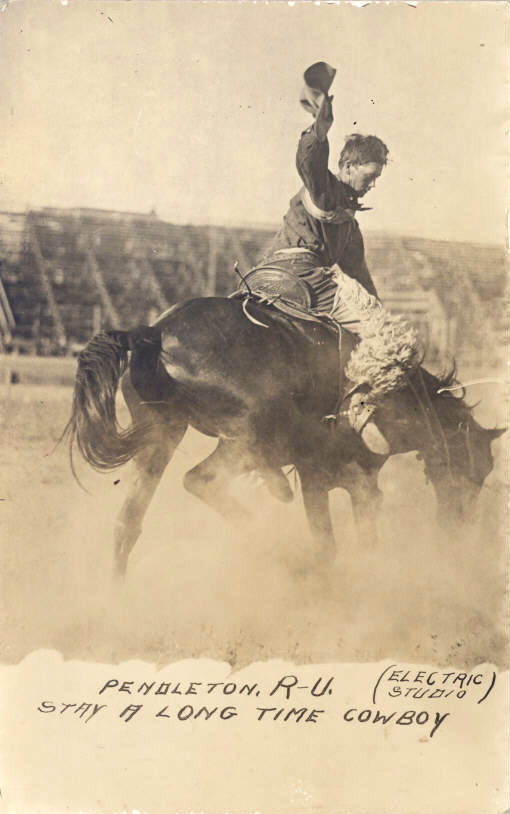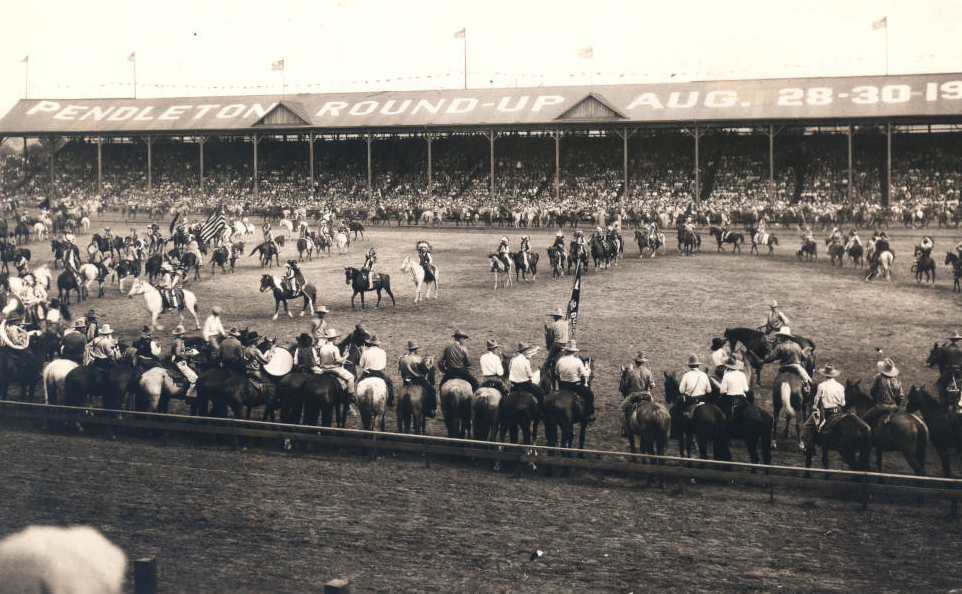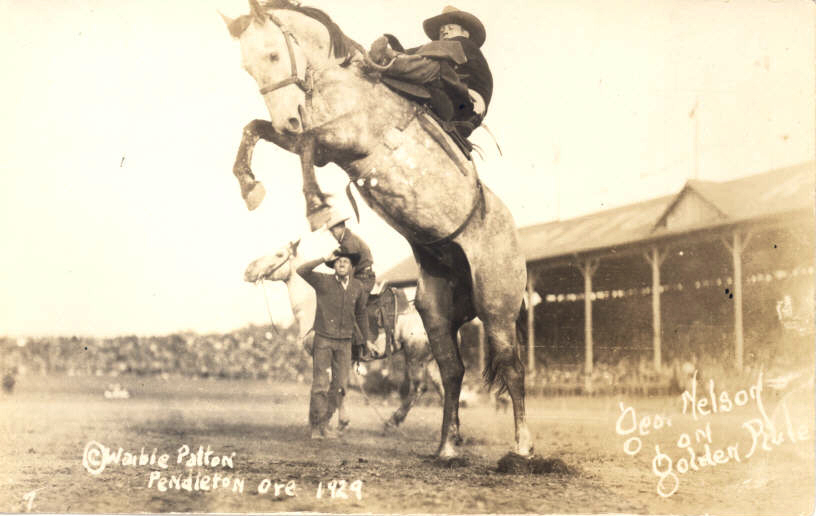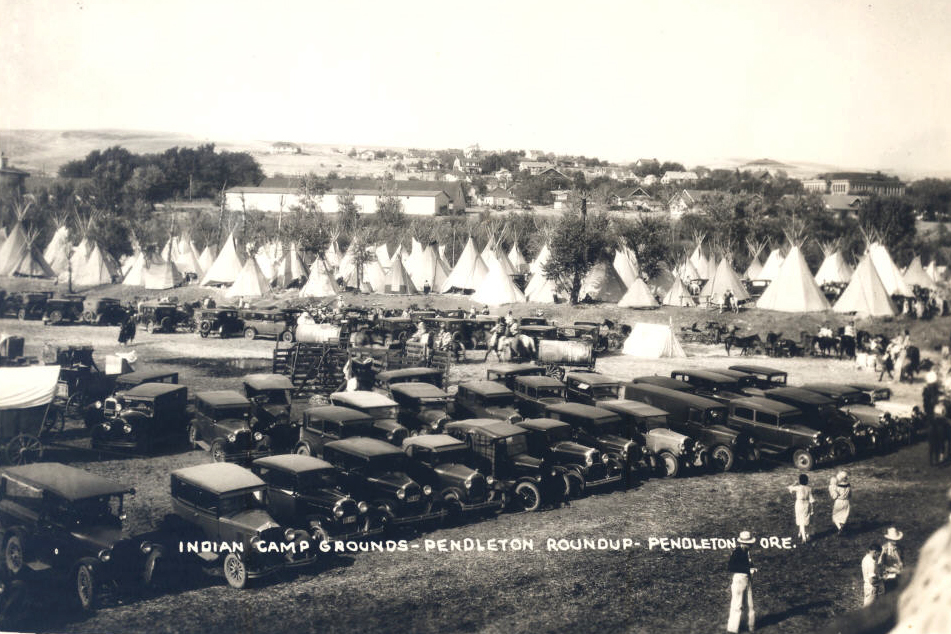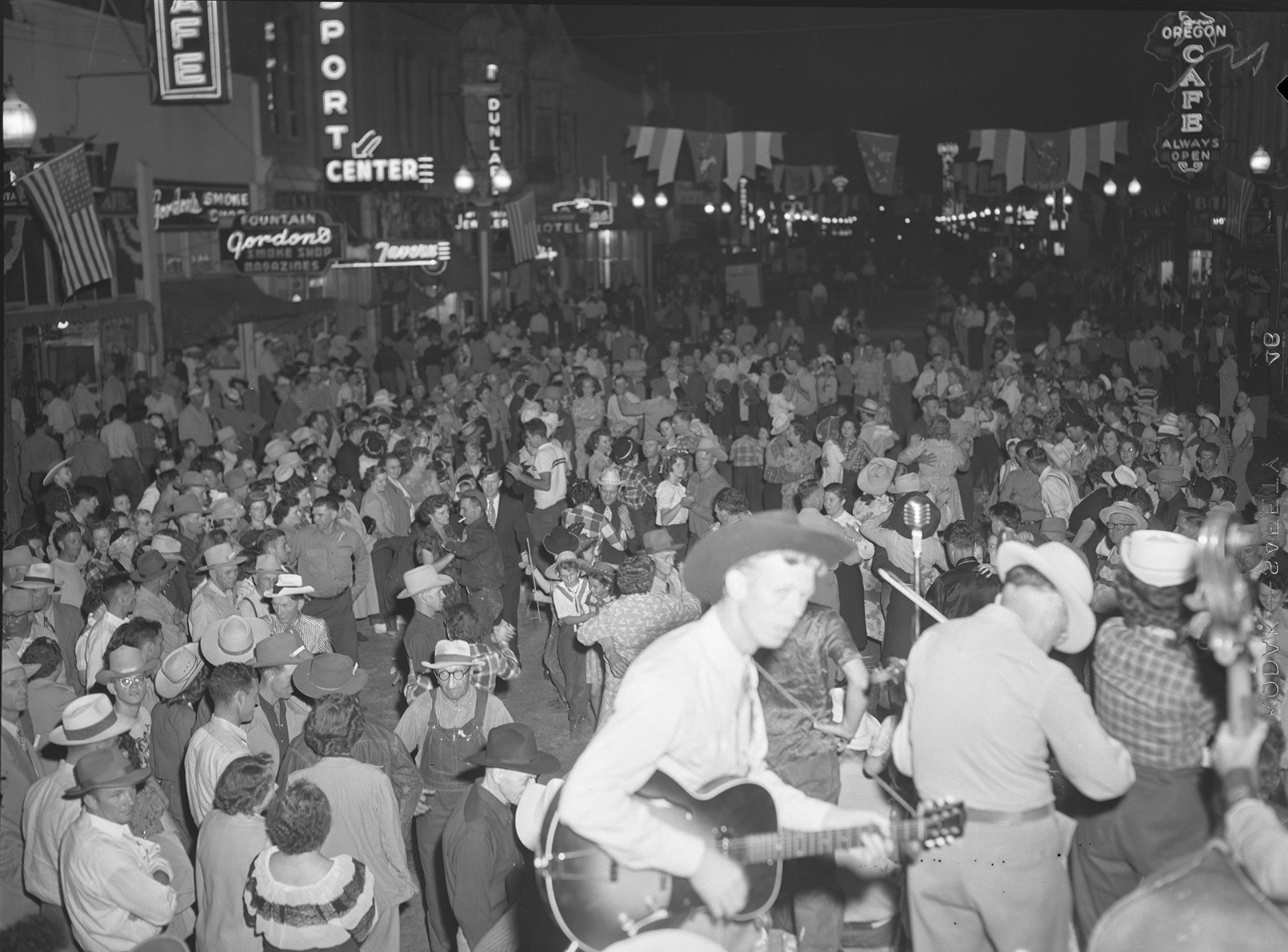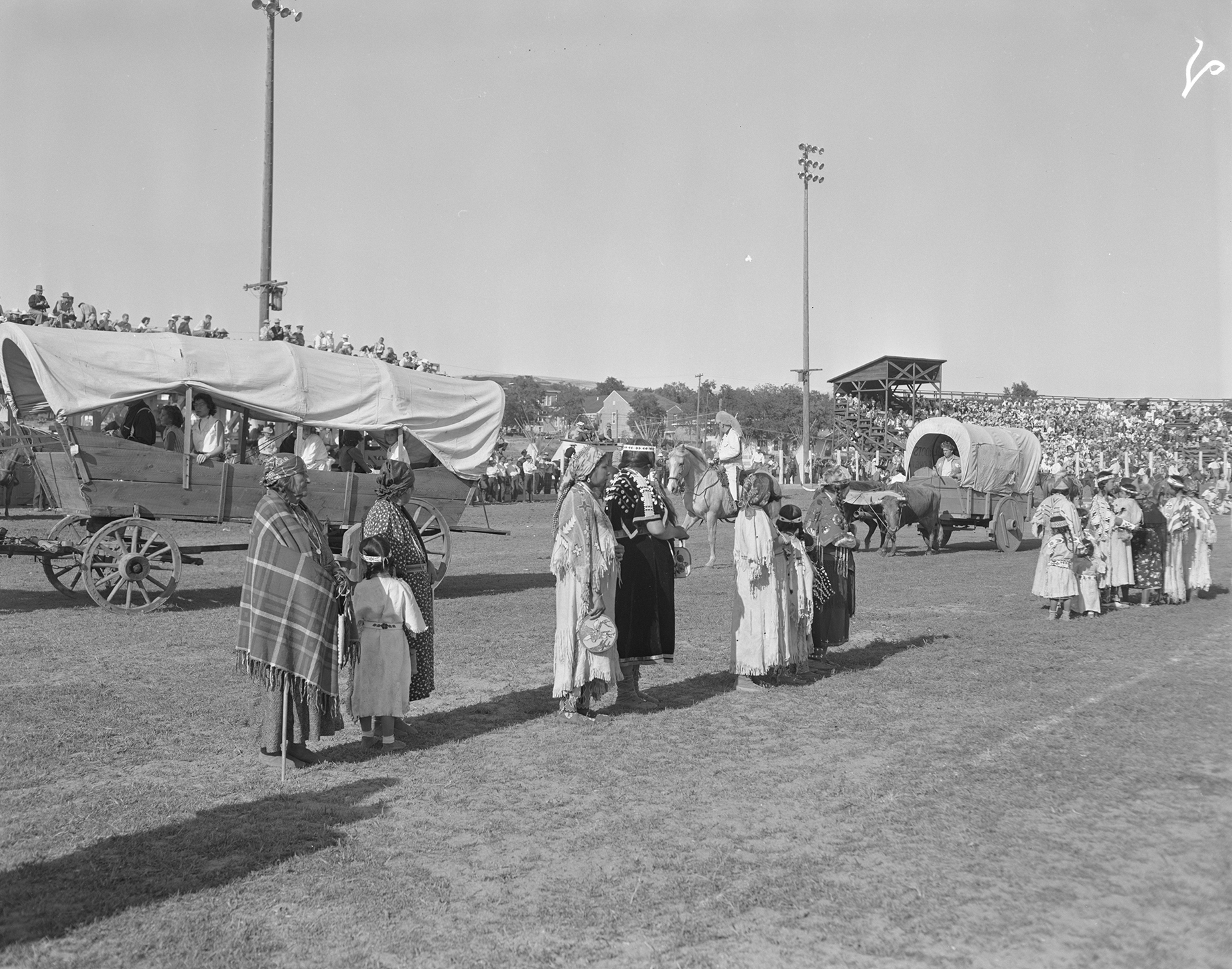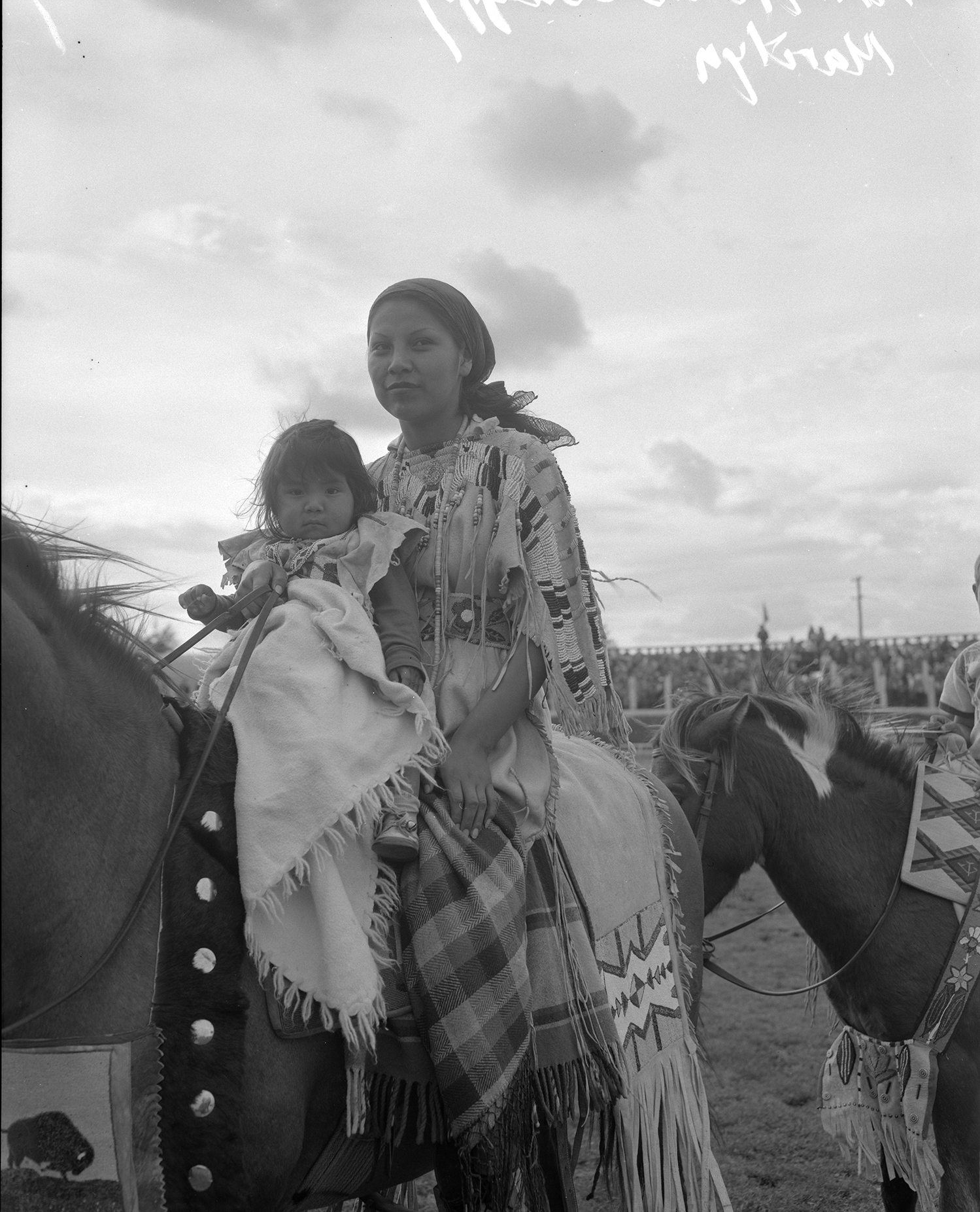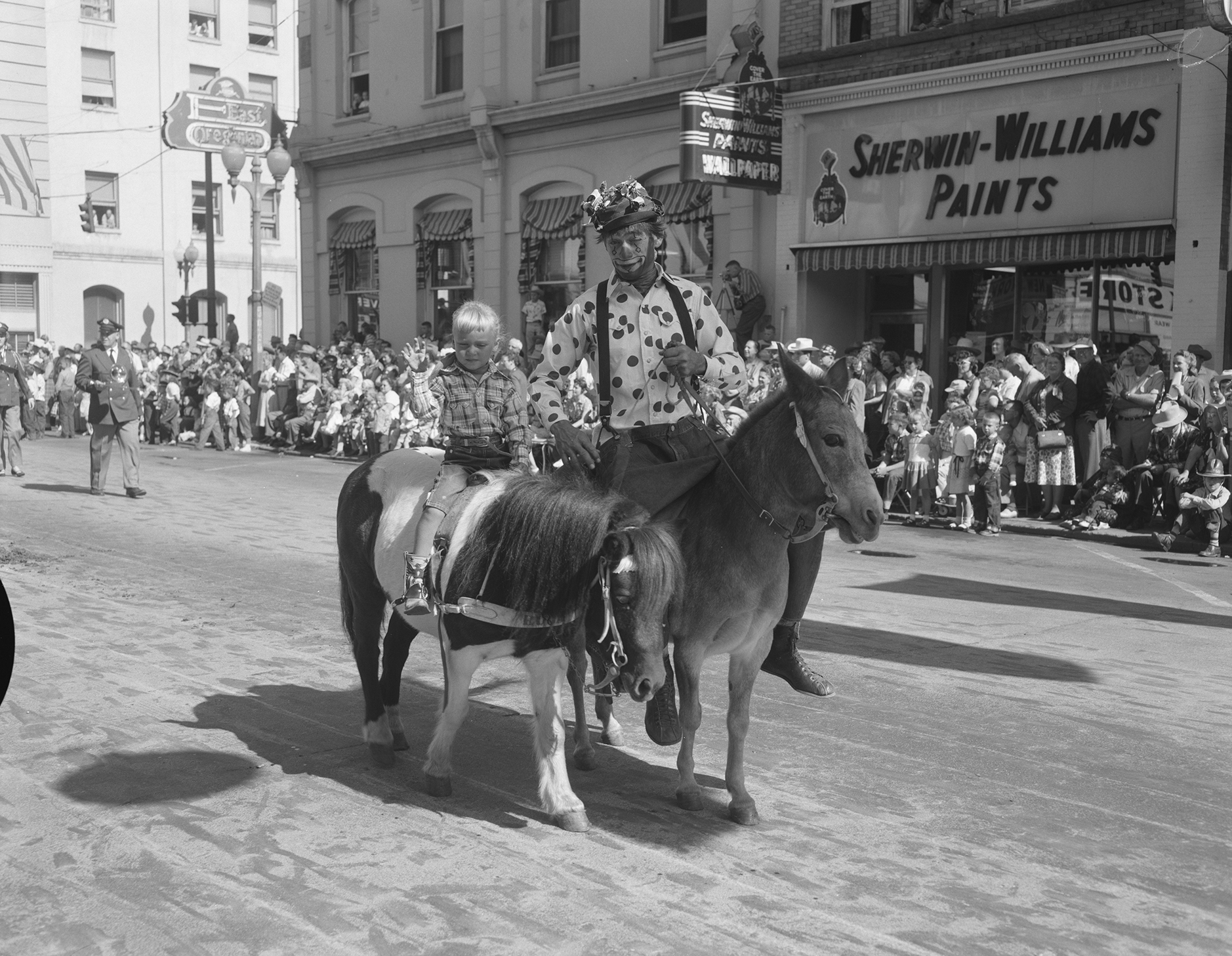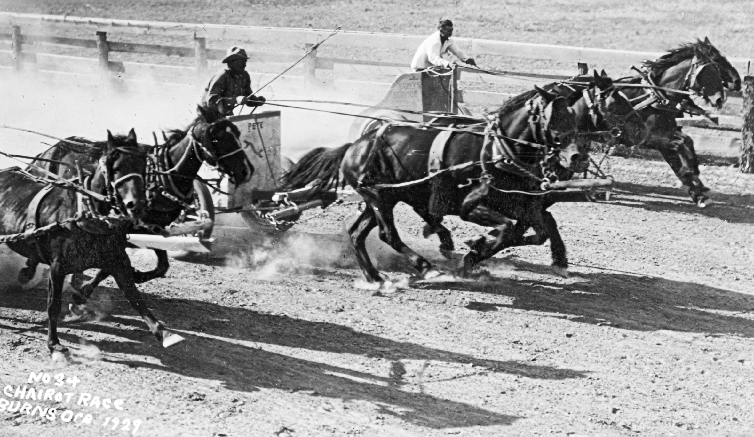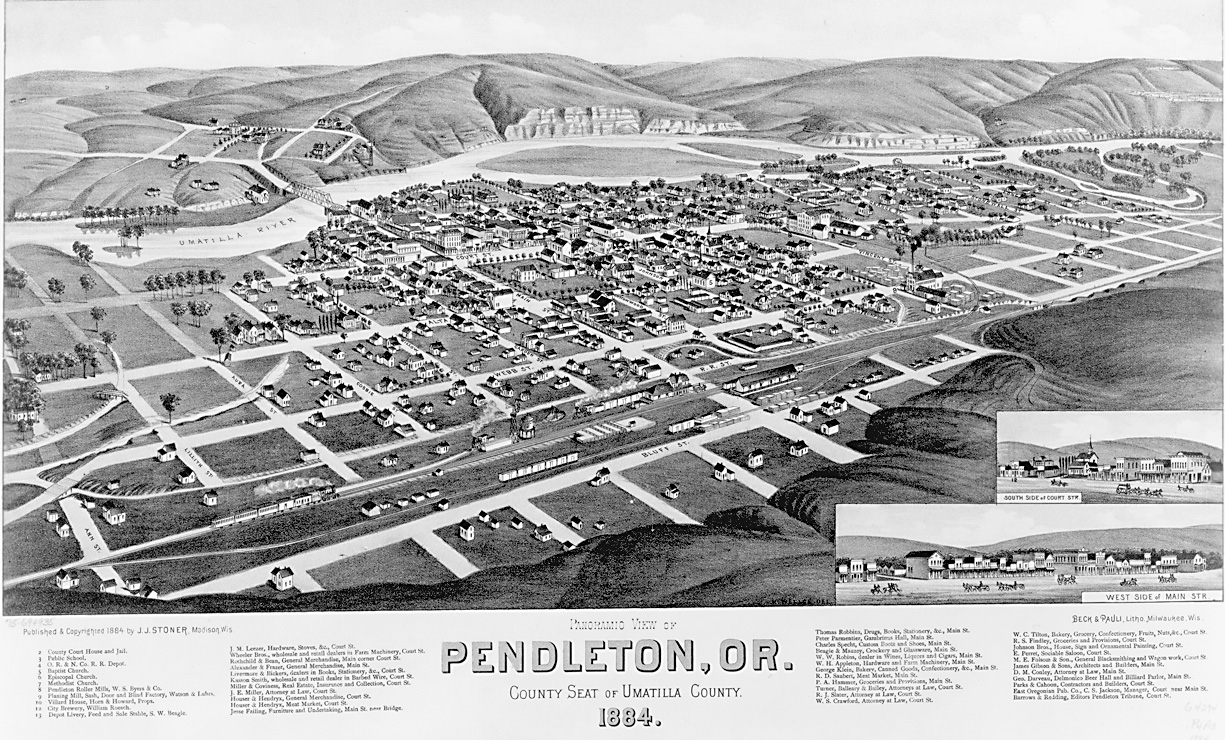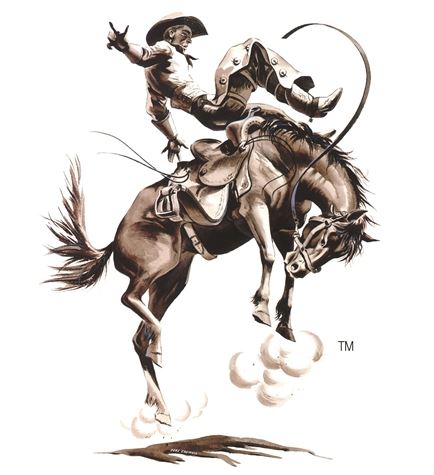The Pendleton Round-Up began in September 1910 as a frontier exhibition of horsemanship and cowboy skills that dazzled 10,000 spectators with its sheer speed and colorful variety over the four-day event. Organizers managed to put the first show together in a little more than three months as a community undertaking. In the over one hundred years since its beginnings, the Pendleton Round-Up has continued each year to present saddle and bareback bronc riding, steer wrestling, calf and steer roping, horse racing, and bull-riding events that capture the daring spirit and rip-roaring cowboy lifestyle of the American frontier.
The founders of the Pendleton Round-Up were among the town’s leading young professionals and businessmen. Led by lawyer Roy Raley, they wanted to hold an entertainment that would put the town of Pendleton on the map and celebrate the community's Wild West roots. Drawing on the inspiration of Buffalo Bill's Wild West shows, the Portland Rose Festival, and community fairs that featured horsemanship and rodeo skills, the Round-Up's organizers strived for something authentic and long-lasting in its presentations.
The Round-Up's performers were not mere actors recreating the past, but actual working cowboys and ranch hands who still broke wild horses and roped and branded cattle on ranches throughout the Northwest. The founders sought out the best livestock to ensure that the cowboys gave exciting, high-quality performances. Over time, the Round-Up has maintained its reputation for drawing top contestants and the highest quality livestock to put on a fast-paced, high-level demonstration of rodeo skills.
From the beginning, a key feature of the Round-Up, and crucial to its continuing success, was the inclusion of Native Americans. Round-Up promoters invited people from the nearby Umatilla Indian Reservation for the Cayuse, Umatilla, and Walla Walla tribes (now the Confederated Tribes of the Umatilla Indian Reservation) and tribal members from throughout the Northwest to participate in the event. They set up a teepee encampment next to the arena grounds and gave demonstrations of traditional dancing, horsemanship, and skills in beadwork, leatherwork, weaving, and basket making.
The overwhelming success of the first show prompted its backers to purchase land along the Umatilla River in Pendleton. They raised funds to build a wooden stadium that sat 10,000 spectators and supporting facilities, including an arena, racetrack, and corrals and barns for the livestock. Eventually, a covered, steel-and-concrete stadium that could accommodate 20,000 viewers replaced the original stands, and supporting facilities have been expanded.
From the beginning, the Round-Up staged the Westward Ho! Parade on the Friday of the four-day event. The parade, which continues to showcase fine horses, cowboy and Native American regalia, and historical horse-drawn vehicles, is reputed to be the largest nonmotorized parade in the United States.
Until 1929, tough-as-nails cowgirls competed in horse racing, bronc busting, and trick roping events. The accidental death of bronc rider Bonnie McCarroll led to the banning of women contestants at the Round-Up for over seventy years. Women contestants returned to the Round-Up in 2000 in the barrel-racing event.
In 1913, the Round-Up added a night show to the program. Roy Raley and Anna C. Minthorn Wannassay, a Cayuse tribal member, wrote a script for an outdoor pageant that depicted traditional Native American life before white settlement, the arrival of white pioneers, and the development of the West. Using pantomime, musical score, and live animals on stage, the Happy Canyon Pageant was a success from the start. The show has continued as an integral feature of the annual Round-Up. Over time, the roles of both Native Americans and whites became the virtual property of the performers and were handed down within families.
Each September, as many as 50,000 spectators crowd into Pendleton to watch the four-day, community-owned and staged event. Operated from the beginning as a nonprofit, all funds that are not used by the Round-Up Association to produce and maintain the show are donated to various local civic organizations and causes. The Pendleton Round-Up was performed during the tough economic times of the Depression, overcame a disastrous stadium fire in August 1940, and came back after a two-year suspension during World War II to thrive as one of the top rodeos in the world.
-
![]()
Trick rider Jillie Baldwin, Pendleton Round-Up, 1912.
Oregon Historical Society Research Library, photo file 855, photo by W.S. Bowman
-
![]()
Roy Bishop with Jackson Sundown, champion bronco rider, Pendleton Round-Up.
Courtesy Oregon Hist. Soc. Research Lib., OrHi59805
-
![]()
Bucking bronco, Pendleton Round-Up, 1910.
Oregon Historical Society Research Library, photo file 855
-
![]()
A woman rides a bucking horse, Pendleton Round-Up, c. 1910s-1920s.
Oregon Historical Society Research Library, photo file 855, 23682
-
![Sharkey was a notorious bull, famous for violently bucking off riders.]()
"Sharkey, That's All." Pendleton Round-Up, c. 1913.
Sharkey was a notorious bull, famous for violently bucking off riders. Oregon Historical Society Research Library, photo file 855
-
![McGinnis was the first woman trick rider to wear pants.]()
Champion trick rider Vera McGinnis in the Drunken Ride, Pendleton Round-Up, c. 1914.
McGinnis was the first woman trick rider to wear pants. Oregon Historical Society Research Library, photo file 855
-
![]()
Jackson Sundown (Nez Perce), rodeo champion, Pendleton Round-Up, 1916.
Oregon Historical Society Research Library, photo file 855, 47300
-
![]()
Jackson Sundown making his championship race on Angel, Pendleton Round-Up, 1916.
Oregon Historical Society Research Library, photo file 855, Orhi63679
-
![]()
George Fletcher.
Courtesy Oreg. Hist. Soc. Research Library
-
![George Fletcher]()
George Fletcher.
George Fletcher Courtesy Oreg. Hist. Soc. Research Library, 67878
-
![]()
"Some Autos," Pendleton Round-Up, 1916.
Oregon Historical Society Research Library, photo file 855
-
![]()
"Arizona," Hugh Strickland, and Tex Smith, Pendleton Round-Up, 1918.
Oregon Historical Society Research Library, photo file 855
-
![]()
Jesse Stahl at the Pendleton Round-Up.
Courtesy Oreg. Hist. Soc. Research Library, 12527
-
![]()
Ray Bell on "You-Tell-Em" in the finals, Pendleton Round-Up, 1920.
Oregon Historical Society Research Library, photo file 855
-
![]()
Bucking contest, Pendleton Round-Up, c. 1920s.
Oregon Historical Society Research Library, photo file 855
-
![]()
Bucking contest, Pendleton Round-Up, c. 1920s.
Oregon Historical Society Research Library, photo file 855, Orhi104435
-
![]()
Norman Gowan, Pendleton Round-Up, c. 1920s.
Oregon Historical Society Research Library, photo file 855
-
![]()
Aerial view of Pendleton Round-Up, c. 1920s.
Oregon Historical Society Research Library, photo file 855, 65116
-
![]()
"Stay a Long Time Cowboy," bronco rider, Pendleton Round-Up, c. 1920s.
Oregon Historical Society Research Library, photo file 855, 08wxKub
-
![Bonnie Grey, Donna Glover, Mable Strickland, Vera McGinnis, and Lorena Trickey.]()
Pendleton Round-Up, 1923.
Bonnie Grey, Donna Glover, Mable Strickland, Vera McGinnis, and Lorena Trickey. Oregon Historical Society Research Library, 21051, photo file 855-A
-
![]()
Chief Tall Pine (Umatilla) bulldogging, Pendleton Round-Up, c. 1924.
Oregon Historical Society Research Library, photo file 855, 56228
-
![]()
Pappy Ryan on Kelly, Pendleton Round-Up, c. 1924.
Oregon Historical Society Research Library, photo file 855, 981d178
-
![]()
Bareback bronco riding, Pendleton Round-Up, 1925.
Oregon Historical Society Research Library, photo file 855
-
![]()
Fox Hastings bulldogging a steer, Pendleton Round-Up, c. 1928.
Oregon Historical Society Research Library, photo file 855
-
![]()
Pendleton Round-Up, opening ceremonies, c. 1928.
Oregon Historical Society Research Library, photo file 855, 17338
-
![]()
George Nelson, on Golden Rule, Pendleton Round-Up, 1929.
Oregon Historical Society Research Library, photo file 855
-
![]()
Indian campground, Pendleton Round-Up, 1930.
Oregon Historical Society Research Library, photo file 855, 54352
-
![]()
Women equestrians, Pendleton Round-Up, 1937.
Oregon Historical Society Research Library, photo file 855, Orhi91294
-
![]()
Indian Relay Race, Pendleton Round-Up, 1948.
Oregon Historical Society Research Library, photo file 855
-
![]()
Native encampment, Pendleton Round-Up, 1950.
Oregon Historical Society Research Library, OrgLot1284_1759_23, Al Monner -
![]()
Dance in downtown Pendleton, Round-Up, 1950.
Oregon Historical Society Research Library, photo file OrgLot1284_1758_10, Al Monner -
![]()
Kids dancing at the Pendleton Round-Up, 1952.
Oregon Historical Society Research Library, OrgLot1284_2007_16, Al Monner -
![]()
Kids dance at the Pendleton Round-Up, 1952.
Oregon Historical Society Research Library, OrgLot1284_2007_11, Al Monner -
![]()
Native and non-Native participants in the Happy Canyon pageant, with covered wagon props, 1952.
Oregon Historical Society Research Library, photo file OrgLot1284_2007_4, Al Monner -
![]()
Marilyn Sohappy (Yakama) with her daughter, Pendleton Round-Up, 1954.
Oregon Historical Society Research Library, OrgLot1284_2353_10, Al Monner -
![]()
Pendleton Round-Up parade, 1956.
Oregon Historical Society Research Library, OrgLot1284_2746_4, Al Monner -
![]()
Pendleton Round-Up Court at the Junior Rose Festival Parade, Portland, 1958.
Oregon Historical Society Research Library, OrgLot1284_3111_1, Al Monner -
![]()
Casey Tibbs, Pendleton Round-Up, 1958.
Oregon Historical Society Research Library, OrgLot1284_3170_6, Al Monner -
![]()
Pendleton Round-Up Royal Court, 1960.
Oregon Historical Society Research Library, photo file 855, photo by Howdy Shell
-
![]()
Native woman and a baby in a cradleboard, Pendleton Round-Up, 1961.
Oregon Historical Society Research Library, photo file 855, Orhi105556
-
![]()
Anne Johnson (Umatilla), center, with great-grandchildren Pauline Sam and Anna Marie Chapman, Pendleton Round-Up, 1961.
Oregon Historical Society Research Library, photo file 855
-
![]()
Norma Paulus campaigning for governor at the 1986 Pendleton Round-Up parade.
Courtesy Paulus family
Related Entries
-
![Black Cowboys in Oregon]()
Black Cowboys in Oregon
The history of African American cowboys in Oregon begins well past the …
-
Harney County Fair, Rodeo, and Race Meet
The first “fair” in Harney County was a media event. On July 4, 1888, a…
-
![Pendleton]()
Pendleton
Pendleton, a city of 17,107 in the 2020 census, sits in the foothills o…
-
![Pendleton Woolen Mills]()
Pendleton Woolen Mills
Pendleton Woolen Mills opened in 1909 in a defunct woolen mill that had…
-
![St. Paul Rodeo]()
St. Paul Rodeo
On July 4, 1936, the Willamette Valley town of St. Paul held its first …
Related Historical Records
Map This on the Oregon History WayFinder
The Oregon History Wayfinder is an interactive map that identifies significant places, people, and events in Oregon history.
Further Reading
Bales, Michael, Terry Hill, et. al. Pendleton Round-Up at 100: Oregon's Legendary Rodeo. Portland, Ore.: Graphic Arts Books, 2009.
Stratton, W. K. Chasing the Rodeo. New York: Harcourt, Inc., 2005.


